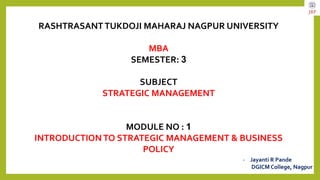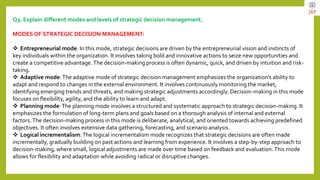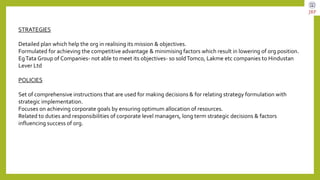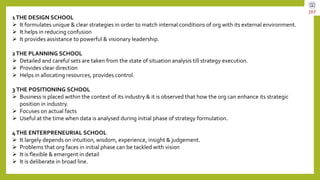The document discusses strategic management and business policy, highlighting their differences and the importance of effective decision-making in organizations. It outlines the process of forming business policies, the nature of strategic decision-making, and various modes and levels of strategic management. Additionally, it emphasizes the role of top management in formulating strategies that align with organizational goals and the need for continuous monitoring and adaptation to changing environments.















![LEVELS OF STRATEGY
1 CORPORATE
STRATEGY
2 BUSINESS
STRATEGY
3 FUNCTIONAL
STRATEGY
Plans ofTop Management for
supervising overall functioning
of firm & achieving expected
performance.
Outlines org activities &
objectives in diff areas like
product lines, technologies,
consumers & their needs.
Guides an org to become what
it wants, maximises
performance level
Eg Nokia [alliance with
Microsoft]
Strategic Business Unit SBU is based on
recognising separate market segment
created by the company.
Formulated separately for each segment
due to differences in their environmental
condition
Formulated to satisfy needs of customers
of each segment thus increasing &
sustaining competitive advantage
Dominos Pizza –Turnaround Strategy
Denotes operating division levels
& departments in an org like
marketing, finance, HR, R&D
Business and Corporate strategy
depend on this strategy for info
regarding resources &
capabilities.
Eg Marketing strategy can be
broken into functional levels like-
Pricing strategies
Distribution strategies
Promotion strategies
Sales strategies](https://image.slidesharecdn.com/strategicmanagementmodule1-230623151554-31399f03/85/Strategic-Management-Module-1-pdf-16-320.jpg)


![1] ENVIRONMENTAL SCANNING
It is identifying external & internal elements that will determine the future of the corporation.
Environmental Scanning is done through SWOT analysis.
SWOT = Strength,Weakness, Opportunity,Threat
External Environment: Opportunities &Threats
Internal Environment: Strengths &Weakness
2] STRATEGY FORMULATION
Formulation of long term organizational plans that assist in carrying out organizational activities in best possible way.
Strategies are framed by looking the future of org in long run.
Strategies define the course of action an org would choose to reach its goals.
This involves -
DevelopingVision
Identifying corporate Mission
Setting realistic objectives
Formulating strategies
Establishing policy guidelines](https://image.slidesharecdn.com/strategicmanagementmodule1-230623151554-31399f03/85/Strategic-Management-Module-1-pdf-19-320.jpg)
![VISIONOF ORG
• Position that the org aspires to achieve in future.
• It is developed by top management [CEO, President, Director,Chairman, etc]
• The basic idea behind formulating vision is to provide a concentrated view of the org.
• It provides employees with a common goal & stimulate them for conducting their routine operations efficiently.
MISSIONOF ORG
• It is the reason for existence of the org.
• Specifies organizational Culture &Values
• Sets guiding points for carrying out activities of the business org
• Unique statement that defines the products, markets & geographical scope of the business, market price, etc.
OBJECTIVES
• They are the results one expects out of the business activities.
• Symbolise that management is committed towards achieving desired result under specific time period.
• Helps in setting performance standards on the basis of which performance is evaluated.
• Harmony between decision & decision makers.](https://image.slidesharecdn.com/strategicmanagementmodule1-230623151554-31399f03/85/Strategic-Management-Module-1-pdf-20-320.jpg)

![3] STRATEGY IMPLEMENTATION
Without successful implementation, a well devised strategy is of no use.
It is the process that facilitates in successful execution of the selected strategy.
Strategies are implemented with the help of Programmes, Budgets & Procedures.
Implementation is generally conducted by the middle or lower management after being assessed by the top management.
PROGRAMMES
Actions/Steps needed to implement single use plan.
Help in putting the strategies into action.
Eg –
Corporate restructuring,Changing org culture, Initiating a new research project
BUDGETS
Declaration of org programme in monetary terms.
Represents cost entailed in each programme.
Used in purpose of planning & control
PROCEDURES
Standard Operating Procedures [SOP] – step by step explanation of the order in which a task is to be carried out
Provide explanation regarding no. of operations that are necessary for completion of programmes.](https://image.slidesharecdn.com/strategicmanagementmodule1-230623151554-31399f03/85/Strategic-Management-Module-1-pdf-22-320.jpg)
![4] EVALUATION & CONTROL
After successful strategy implementation, it is necessary to evaluate it on regular basis.
Helps in monitoring the whole procedure.
Strategic objectives & performance measures are base for evaluating effectiveness of strategy.
For assessment between expected and actual results.
Managers role to monitor the expected response from diff sectors.
Analysing market response.
Factors that determine extent to which strategic control is necessary-
Size of org
Business activities
No. of business segments
Org structure
Performance is final outcome of all activities involved in the process of strategic management.
Successful evaluation of strategy is based on suitable and prompt feedback.
Effectiveness of strategy evaluation depends on info provided by the subordinates.](https://image.slidesharecdn.com/strategicmanagementmodule1-230623151554-31399f03/85/Strategic-Management-Module-1-pdf-23-320.jpg)



